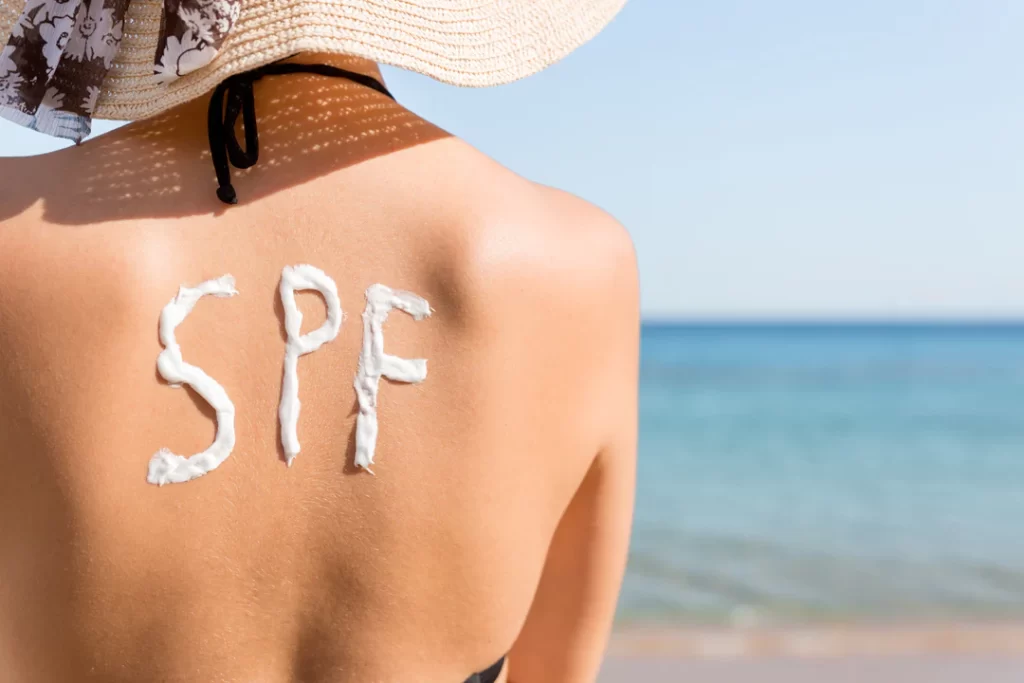
How does Sun Protection Factor (SPF) work?
We all know how important it is to use and stock up on Sun Protection Factor (SPF) before summer vacation, but we are not ashamed to admit that we have no idea what SPF actually does or exactly what it does. So, we did some research, and in today’s blog post, we are going to share with you everything we learned about SPF.
Before we dive in, I first want to explain the difference between UVB and UVA in a little more detail. Both rays damage the skin in their own way. The easiest way to remember it is: UVB = Burns and affects the surface of the skin, causing the burning sensation you feel from excessive sun exposure. UVA = Aging, which generally means that these rays can penetrate deep into the skin, reaching the underlying layers and causing skin aging, such as: B. The breakdown of collagen and elastin. UVA is persistent and requires year-round protection, as it can penetrate clouds, glass, and water. Many skin experts recommend using a sunscreen with SPF every day to adequately protect the skin, even on cloudy and overcast days.
What is Sun Protection Factor SPF?
In short, SPF is a product that blocks the sun’s rays from causing damage or burning to your skin. Generally speaking, the higher the factor, the more effective it is in blocking UV radiation. Noting down the SPF number will help you better estimate how long you can safely stay in direct sunlight before your skin starts to burn.
To better understand how well this factor protects your skin, consider how long it takes for your skin to turn pink in direct sunlight. If your skin turns pink quickly, choosing the highest factor will protect your skin from burning longer. With SPF 30, you can generally get about 5 hours of sun protection. This is determined by multiplying the time it takes you to get a sunburn without protection by the SPF number.
To find out how long SPF will work for you, you need to do the following:
Consider your skin type and how easily you burn.
Apply a generous amount, about one tablespoon per limb, or more if you have a larger area.
Keep a note of the time you apply SPF so you can be prepared to reapply.
Reapply when you are in water or sweating.
Stay out of direct sunlight during the hottest part of the day.
Being vigilant when in the sun can protect your skin without showing signs of sunburn.
When using SPF for your face, it is recommended that you use products designed for the face to avoid problems with clogged pores, which can sometimes even lead to breakouts. Always cleanse your skin thoroughly and follow up with a strong skincare regimen rich in active ingredients to keep your skin healthy, radiant and spot-free.
How is the sun protection factor of a sunscreen determined?
SPF is a way of measuring the effects of UV radiation and how long it takes for your skin to become damaged by sun exposure. It was first introduced in 1974, and while the results cannot be considered waterproof, it allows SPF users to control the amount of sun exposure on their skin, with UVB primarily protecting the skin from sunburn.
UVA is a little harder to avoid, as the effects of these rays are invisible, i.e. you can’t see the effects of sun exposure very quickly. Therefore, broad-spectrum sunscreens with SPF were developed to protect the skin from both UVB and UVA. You can also check the ingredient list on the packaging to see if the formula contains substances like zinc oxide or titanium dioxide, as they can better protect your skin.
To achieve long-term benefits, it is recommended to follow a safe sun protection routine that includes amazing sun exposure, generous application of SPF to the skin, frequent reapplication, and adequate hydration.
When should you reapply sunscreen?
SPFs become less effective when in direct sunlight, so reapplication is an important step in your skincare routine.
If you go to work and don’t anticipate being in the sun for long periods of time, you will find that the SPF you apply as part of your morning skincare routine will provide you with adequate protection while driving to and from work.
If you anticipate being outside for longer periods of time, reapplication after 2 hours will provide you with the best sun protection. You will find that many skincare products, especially moisturizers, contain SPF ingredients, and using them is a good start to sun protection. However, there is a common skin myth that says that if you stack several different sunscreen products, you will get a higher level of sun protection. Unfortunately, this is not true, as it is an end-factor that overrides any other factors you may have applied to your skin. For example, if your daily moisturizer contains factor 15 before using SPF 30, factor 30 will provide skin protection.
What is the best sunscreen with SPF?
Any form of SPF is better than no sun protection! The formulations and ingredients of everyday SPF products have come on leaps and bounds since the 1970s, so I’m sure there’s a product out there that’s right for you. From built-in SPFs to moisturizers, mineral solutions, sprays, and lightweight day creams, no matter your skin type, you’ll find a product that will protect your skin from UV rays and damage while preventing other skin issues like breakouts.
It’s important to understand that everyone’s skin is the same and needs sun protection. So even if you just throw on a hat or sunglasses, or slather on sunscreen from head to toe, you’re doing it to protect your skin, and it’ll thank you for it.


